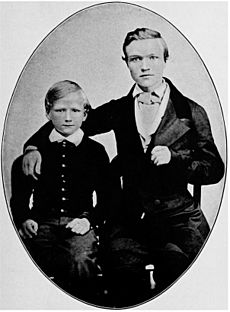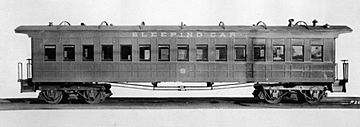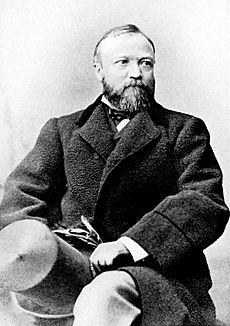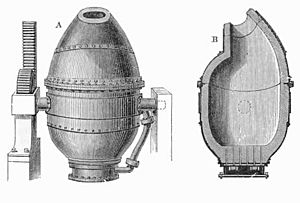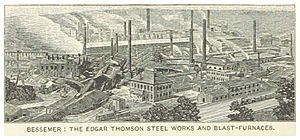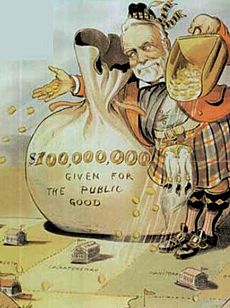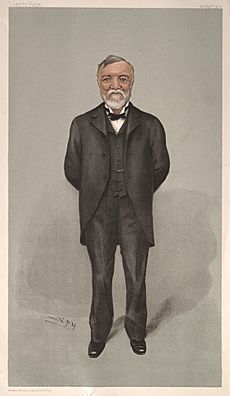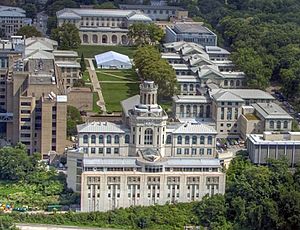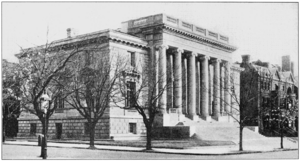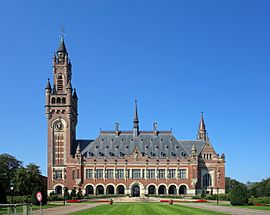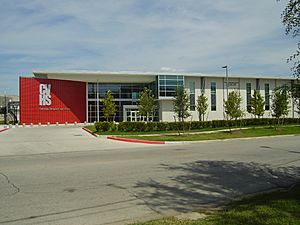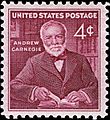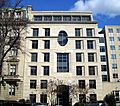Andrew Carnegie facts for kids
Quick facts for kids
Andrew Carnegie
|
|
|---|---|
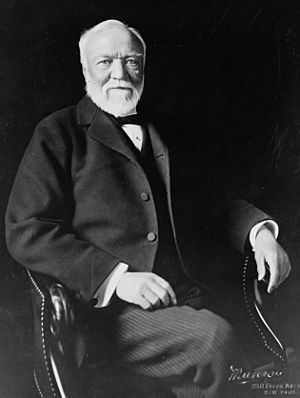
Carnegie in 1913
|
|
| Born | November 25, 1835 Dunfermline, Fife, Scotland
|
| Died | August 11, 1919 (aged 83) Lenox, Massachusetts, U.S.
|
| Resting place | Sleepy Hollow Cemetery, Sleepy Hollow, New York, U.S. |
| Occupation | Industrialist, Philanthropist |
| Known for | Founding and leading the Carnegie Steel Company Founding the Carnegie Library, Carnegie Hall, Carnegie Institution for Science, Carnegie Corporation of New York, Carnegie Endowment for International Peace, Carnegie Mellon University, Carnegie Trust for the Universities of Scotland, Carnegie United Kingdom Trust, Carnegie Foundation for the Advancement of Teaching, Carnegie Council for Ethics in International Affairs, Carnegie Museums of Pittsburgh, and the Carnegie Hero Fund |
| Political party | Republican |
| Spouse(s) | |
| Children | Margaret Carnegie Miller |
| Parent(s) | William Carnegie Margaret Morrison Carnegie |
| Relatives | Thomas M. Carnegie (brother) George Lauder (first cousin) George Lauder Sr. (uncle) |
| Signature | |
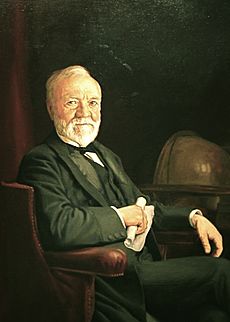
Andrew Carnegie was an American industrialist and philanthropist. Carnegie led the expansion of the American steel industry in the late 19th century and became one of the richest Americans in history. He became a leading philanthropist in the United States, Great Britain, and the British Empire. During the last 18 years of his life, he gave away around $350 million (roughly $5.9 billion in 2022), almost 90 percent of his fortune, to charities, foundations and universities. His 1889 article proclaiming "The Gospel of Wealth" called on the rich to use their wealth to improve society, expressed support for progressive taxation and an estate tax, and stimulated a wave of philanthropy.
Contents
Biography
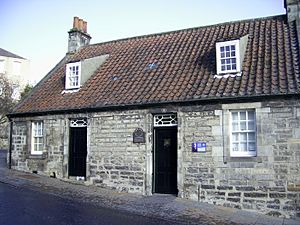
Andrew Carnegie was born to Margaret Morrison Carnegie and William Carnegie in Dunfermline, Scotland. He was educated at the Free School in Dunfermline.
Carnegie's maternal uncle, Scottish political leader George Lauder Sr., deeply influenced him as a boy by introducing him to Robert Burns' writings and historical Scottish heroes such as Robert the Bruce, William Wallace, and Rob Roy. Lauder's son, also named George Lauder, grew up with Carnegie and became his business partner. When Carnegie was 12, his father had fallen on tough times as a handloom weaver. Making matters worse, the country was in starvation. His mother helped support the family by assisting her brother and by selling potted meats at her "sweetie shop", leaving her as the primary breadwinner. Struggling to make ends meet, the Carnegies then decided to borrow money from George Lauder, Sr. and move to Allegheny, Pennsylvania, in the United States in 1848 for the prospect of a better life. Carnegie's migration to America would be his second journey outside Dunfermline—the first being an outing to Edinburgh to see Queen Victoria.
In September 1848, Carnegie arrived with his family in Allegheny. Carnegie's father struggled to sell his product on his own. Eventually, the father and son both received job offers at the same Scottish-owned cotton mill, Anchor Cotton Mills. Carnegie's first job in 1848 was as a bobbin boy, changing spools of thread in a cotton mill 12 hours a day, 6 days a week in a Pittsburgh cotton factory. His starting wage was $1.20 per week ($41 by 2024 inflation).
His father quit his position at the cotton mill soon after, returning to his loom and removing him as breadwinner once again. But Carnegie attracted the attention of John Hay, a Scottish manufacturer of bobbins, who offered him a job for $2.00 per week ($68 by 2024 inflation).
In 1849, Carnegie became a telegraph messenger boy in the Pittsburgh Office of the Ohio Telegraph Company, at $2.50 per week ($88 by 2024 inflation) following the recommendation of his uncle. He was a hard worker and would memorize all of the locations of Pittsburgh's businesses and the faces of important men. He made many connections this way. He also paid close attention to his work and quickly learned to distinguish the different sounds the incoming telegraph signals produced. He developed the ability to translate signals by ear, without using the paper slip, and within a year was promoted to an operator. Carnegie's education and passion for reading were given a boost by Colonel James Anderson, who opened his personal library of 400 volumes to working boys each Saturday night. Carnegie was a consistent borrower and a "self-made man" in both his economic development and his intellectual and cultural development. He was so grateful to Colonel Anderson for the use of his library that he "resolved, if ever wealth came to me, [to see to it] that other poor boys might receive opportunities similar to those for which we were indebted to the nobleman". His capacity, his willingness for hard work, his perseverance and his alertness soon brought him opportunities.
Starting in 1853, when Carnegie was around 18 years old, Thomas A. Scott of the Pennsylvania Railroad employed him as a secretary/telegraph operator at a salary of $4.00 per week ($141 by 2024 inflation). Carnegie accepted the job with the railroad as he saw more prospects for career growth and experience there than with the telegraph company. At age 24, Carnegie officially became superintendent of the Western Division. Carnegie then hired his sixteen-year-old brother Tom to be his personal secretary and telegraph operator. Not only did Carnegie hire his brother, he also hired his cousin, Maria Hogan, who became the first female telegraph operator in the country. As superintendent Carnegie made a salary of $1500 a year ($49,000 by 2024 inflation). His employment by the Pennsylvania Railroad would be vital to his later success. The railroads were the first big businesses in America, and the Pennsylvania was one of the largest of them all. Carnegie learned much about management and cost control during these years, and from Scott in particular.
Scott also helped him with his first investments.
Before the Civil War, Carnegie arranged a merger between Woodruff's company and that of George Pullman, the inventor of the sleeping car for first-class travel, which facilitated business travel at distances over 500 miles (800 km). The investment proved a success and a source of profit for Woodruff and Carnegie. The young Carnegie continued to work for Pennsylvania's Tom Scott and introduced several improvements in the service.
In the spring of 1861, Carnegie was appointed by Scott, who was now Assistant Secretary of War in charge of military transportation, as Superintendent of the Military Railways and the Union Government's telegraph lines in the East. Carnegie helped open the rail lines into Washington D.C. that the rebels had cut; he rode the locomotive pulling the first brigade of Union troops to reach Washington D.C. Following the defeat of Union forces at Bull Run, he personally supervised the transportation of the defeated forces. Under his organization, the telegraph service rendered efficient service to the Union cause and significantly assisted in the eventual victory. Carnegie later joked that he was "the first casualty of the war" when he gained a scar on his cheek from freeing a trapped telegraph wire.
The defeat of the Confederacy required vast supplies of munitions and railroads (and telegraph lines) to deliver the goods. The war demonstrated how integral the industries were to American success.
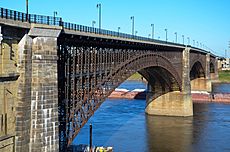
In 1864, Carnegie was one of the early investors in the Columbia Oil Company in Venango County, Pennsylvania. In one year, the firm yielded over $1 million in cash dividends, and petroleum from oil wells on the property sold profitably. The demand for iron products, such as armor for gunboats, cannons, and shells, as well as a hundred other industrial products, made Pittsburgh a center of wartime production. Carnegie worked with others in establishing a steel rolling mill, and steel production and control of industry became the source of his fortune. Carnegie had some investments in the iron industry before the war.
After the war, Carnegie left the railroads to devote his energies to the ironworks trade. Carnegie worked to develop several ironworks, eventually forming the Keystone Bridge Works and the Union Ironworks, in Pittsburgh. Although he had left the Pennsylvania Railroad Company, he remained connected to its management, namely Thomas A. Scott and J. Edgar Thomson. He used his connection to the two men to acquire contracts for his Keystone Bridge Company and the rails produced by his ironworks. He also gave stock in his businesses to Scott and Thomson, and the Pennsylvania was his best customer. When he built his first steel plant, he made a point of naming it after Thomson. As well as having good business sense, Carnegie possessed charm and literary knowledge. He was invited to many important social functions, which Carnegie exploited to his advantage.
Carnegie, through Keystone, supplied the steel for and owned shares in the landmark Eads Bridge project across the Mississippi River at St. Louis, Missouri (completed 1874). This project was an important proof-of-concept for steel technology, which marked the opening of a new steel market.
Carnegie believed in using his fortune for others and doing more than making money. He wrote:
I propose to take an income no greater than $50,000 per annum! Beyond this I need ever earn, make no effort to increase my fortune, but spend the surplus each year for benevolent purposes! Let us cast aside business forever, except for others. Let us settle in Oxford and I shall get a thorough education, making the acquaintance of literary men. I figure that this will take three years' active work. I shall pay especial attention to speaking in public. We can settle in London and I can purchase a controlling interest in some newspaper or live review and give the general management of it attention, taking part in public matters, especially those connected with education and improvement of the poorer classes. Man must have no idol and the amassing of wealth is one of the worst species of idolatry! No idol is more debasing than the worship of money! Whatever I engage in I must push inordinately; therefore should I be careful to choose that life which will be the most elevating in its character. To continue much longer overwhelmed by business cares and with most of my thoughts wholly upon the way to make more money in the shortest time, must degrade me beyond hope of permanent recovery. I will resign business at thirty-five, but during these ensuing two years I wish to spend the afternoons in receiving instruction and in reading systematically!
Carnegie made his fortune in the steel industry, controlling the most extensive integrated iron and steel operations ever owned by an individual in the United States. One of his two great innovations was in the cheap and efficient mass production of steel by adopting and adapting the Bessemer process, which allowed the high carbon content of pig iron to be burnt away in a controlled and rapid way during steel production. Steel prices dropped as a result, and Bessemer steel was rapidly adopted for rails; however, it was not suitable for buildings and bridges.
The second was in his vertical integration of all suppliers of raw materials. In 1883, Carnegie bought the rival Homestead Steel Works, which included an extensive plant served by tributary coal and iron fields, a 425-mile-long (684 km) railway, and a line of lake steamships. In the late 1880s, Carnegie Steel was the largest manufacturer of pig iron, steel rails, and coke in the world, with a capacity to produce approximately 2,000 tons of pig iron per day.
By 1889, the U.S. output of steel exceeded that of the UK, and Carnegie owned a large part of it. Carnegie's empire grew to include the J. Edgar Thomson Steel Works in Braddock (named for John Edgar Thomson, Carnegie's former boss and president of the Pennsylvania Railroad), the Pittsburgh Bessemer Steel Works, the Lucy Furnaces, the Union Iron Mills, the Union Mill (Wilson, Walker & County), the Keystone Bridge Works, the Hartman Steel Works, the Frick Coke Company, and the Scotia ore mines. Carnegie combined his assets and those of his associates in 1892 with the launching of the Carnegie Steel Company.
Carnegie's success was also due to his relationship with the railroad industries, which not only relied on steel for track, but were also making money from steel transport. The steel and railroad barons worked closely to negotiate prices instead of allowing free-market competition.
Besides Carnegie's market manipulation, United States trade tariffs were also working in favor of the steel industry. Carnegie spent energy and resources lobbying Congress for a continuation of favorable tariffs from which he earned millions of dollars a year. Carnegie tried to keep this information concealed, but legal documents released in 1900, during proceedings with the ex-chairman of Carnegie Steel, Henry Clay Frick, revealed how favorable the tariffs had been.
In 1901, Carnegie was 65 years of age and considering retirement. He reformed his enterprises into conventional joint stock corporations as preparation for this. John Pierpont Morgan was a banker and America's most important financial deal maker. He had observed how efficiently Carnegie produced profits. He envisioned an integrated steel industry that would cut costs, lower prices to consumers, produce in greater quantities and raise wages to workers. To this end, he needed to buy out Carnegie and several other major producers and integrate them into one company, thereby eliminating duplication and waste. He concluded negotiations on March 2, 1901, and formed the United States Steel Corporation. It was the first corporation in the world with a market capitalization of over $1 billion.
The buyout, secretly negotiated by Charles M. Schwab (no relation to Charles R. Schwab), was the largest such industrial takeover in United States history to date. The holdings were incorporated in the United States Steel Corporation, a trust organized by Morgan, and Carnegie retired from business. His steel enterprises were bought out for $303,450,000.
Carnegie's share of this amounted to $225.64 million (in 2022, $7.94 billion), which was paid to him in the form of 5%, 50-year gold bonds. The letter agreeing to sell his share was signed on February 26, 1901. On March 2, the circular formally filed the organization and capitalization (at $1.4 billion—4% of the U.S. gross domestic product at the time) of the United States Steel Corporation actually completed the contract. The bonds were to be delivered within two weeks to the Hudson Trust Company of Hoboken, New Jersey, in trust to Robert A. Franks, Carnegie's business secretary. There, a special vault was built to house the physical bulk of nearly $230 million worth of bonds.
Philanthropist
Carnegie spent his last years as a philanthropist. From 1901 forward, public attention was turned from the shrewd business acumen which had enabled Carnegie to accumulate such a fortune, to the public-spirited way in which he devoted himself to utilizing it on philanthropic projects. He had written about his views on social subjects and the responsibilities of great wealth in Triumphant Democracy (1886) and Gospel of Wealth (1889). Carnegie devoted the rest of his life to providing capital for purposes of public interest and social and educational advancement. He saved letters of appreciation from those he helped in a desk drawer labeled "Gratitude and Sweet Words."
He provided $25,000 a year to the movement for spelling reform. His organization, the Simplified Spelling Board, created the Handbook of Simplified Spelling, which was written wholly in reformed spelling.
3,000 public libraries
Among his many philanthropic efforts, the establishment of public libraries throughout the United States, Britain, Canada and other English-speaking countries was especially prominent. In this special driving interest of his, Carnegie was inspired by meetings with philanthropist Enoch Pratt (1808–1896). The Enoch Pratt Free Library (1886) of Baltimore, Maryland, impressed Carnegie deeply; he said, "Pratt was my guide and inspiration."
Carnegie turned over management of the library project by 1908 to his staff, led by James Bertram (1874–1934). The first Carnegie Library opened in 1883 in Dunfermline. His method was to provide funds to build and equip the library, but only on the condition that the local authority matched that by providing the land and a budget for operation and maintenance.
To secure local interest, in 1885, he gave $500,000 to Pittsburgh, Pennsylvania, for a public library; in 1886, he gave $250,000 to Allegheny City, Pennsylvania, for a music hall and library; and he gave $250,000 to Edinburgh for a free library. In total, Carnegie funded some 3,000 libraries, located in 47 U.S. states, and also in Canada, Britain, Ireland, Australia, New Zealand, South Africa, the West Indies, and Fiji. He also donated £50,000 to help set up the University of Birmingham in 1899.
As Van Slyck (1991) showed, during the last years of the 19th century, there was the increasing adoption of the idea that free libraries should be available to the American public. But the design of such libraries was the subject of prolonged and heated debate. On one hand, the library profession called for designs that supported efficiency in administration and operation; on the other, wealthy philanthropists favored buildings that reinforced the paternalistic metaphor and enhanced civic pride. Between 1886 and 1917, Carnegie reformed both library philanthropy and library design, encouraging a closer correspondence between the two.
-
Edinburgh Central Library
-
Yorkville Library, Ontario.
-
Carnegie Library at Syracuse University, New York
-
Carnegie Library, Moorreesburg, South Africa
Investing in education, science, pensions, civil heroism, music, and world peace
In 1900, Carnegie gave $2 million to start the Carnegie Institute of Technology (CIT) at Pittsburgh and the same amount in 1902 to found the Carnegie Institution at Washington, D.C., for encourage research and discovery. He later contributed more to these and other schools. CIT is now known as Carnegie Mellon University after it merged with the Mellon Institute of Industrial Research. Carnegie also served on the Boards of Cornell University and Stevens Institute of Technology.
In 1911, Carnegie became a sympathetic benefactor to George Ellery Hale, who was trying to build the 100-inch (2.5 m) Hooker Telescope at Mount Wilson, and donated an additional ten million dollars to the Carnegie Institution with the following suggestion to expedite the construction of the telescope: "I hope the work at Mount Wilson will be vigorously pushed, because I am so anxious to hear the expected results from it. I should like to be satisfied before I depart, that we are going to repay to the old land some part of the debt we owe them by revealing more clearly than ever to them the new heavens." The telescope saw first light on November 2, 1917, with Carnegie still alive.
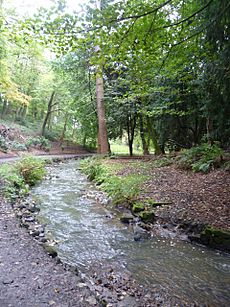
In 1901, in Scotland, he gave $10 million to establish the Carnegie Trust for the Universities of Scotland. It was created by a deed that he signed on June 7, 1901, and it was incorporated by royal charter on August 21, 1902. The establishing gift of $10 million was then an unprecedented sum: at the time, total government assistance to all four Scottish universities was about £50,000 a year. The aim of the Trust was to improve and extend the opportunities for scientific research in the Scottish universities and to enable the deserving and qualified youth of Scotland to attend a university. He was subsequently elected Lord Rector of University of St. Andrews in December 1901, and formally installed as such in October 1902, serving until 1907. He also donated large sums of money to Dunfermline, the place of his birth. In addition to a library, Carnegie also bought the private estate which became Pittencrieff Park and opened it to all members of the public, establishing the Carnegie Dunfermline Trust to benefit the people of Dunfermline. A statue of Carnegie was later built between 1913 and 1914 in the park as a commemoration for his creation of the park.
Carnegie was a major patron of music. He was a founding financial backer of Jeannette Thurber's National Conservatory of Music of America in 1885. He built the music performing venue Carnegie Hall in New York City; it opened in 1891 and remained in his family until 1925. His interest in music led him to fund the construction of 7,000 pipe organs in churches and temples, with no apparent preference for any religious denomination or sect.
He gave a further $10 million in 1913 to endow the Carnegie United Kingdom Trust, a grant-making foundation. He transferred to the trust the charge of all his existing and future benefactions, other than university benefactions in the United Kingdom. He gave the trustees a wide discretion, and they inaugurated a policy of financing rural library schemes rather than erecting library buildings, and of assisting the musical education of the people rather than granting organs to churches.
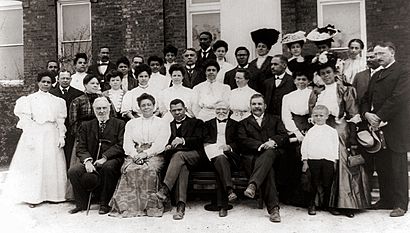
In 1901, Carnegie also established large pension funds for his former employees at Homestead and, in 1905, for American college professors. The latter fund evolved into TIAA-CREF. One critical requirement was that church-related schools had to sever their religious connections to get his money.
Carnegie was a large benefactor of the Tuskegee Institute for African-American education under Booker T. Washington. He helped Washington create the National Negro Business League.
In 1904, he founded the Carnegie Hero Fund for the United States and Canada (a few years later also established in the United Kingdom, Switzerland, Norway, Sweden, France, Italy, the Netherlands, Belgium, Denmark, and Germany) for the recognition of deeds of heroism. Carnegie contributed $1.5 million in 1903 for the erection of the Peace Palace at The Hague; and he donated $150,000 for a Pan-American Palace in Washington as a home for the International Bureau of American Republics.
When it became obvious that Carnegie could not give away his entire fortune within his lifetime, he established the Carnegie Corporation of New York in 1911 "to promote the advancement and diffusion of knowledge and understanding" and continue his program of giving.
Carnegie was honored for his philanthropy and support of the arts by initiation as an honorary member of Phi Mu Alpha Sinfonia fraternity on October 14, 1917, at the New England Conservatory of Music in Boston, Massachusetts. The fraternity's mission reflects Carnegie's values by developing young men to share their talents to create harmony in the world.
By the standards of 19th-century tycoons, Carnegie was not a particularly ruthless man but a humanitarian with enough acquisitiveness to go in the ruthless pursuit of money. "Maybe with the giving away of his money," commented biographer Joseph Wall, "he would justify what he had done to get that money."
To some, Carnegie represents the idea of the American dream. He was an immigrant from Scotland who came to America and became successful. He is not only known for his successes but his huge amounts of philanthropic works, not only for charities but also to promote democracy and independence to colonized countries.
Death
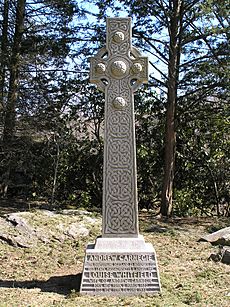
Carnegie died on August 11, 1919, in Lenox, Massachusetts, at his Shadow Brook estate, of Bronchial Pneumonia. He had already given away $350,695,653 (approximately US$5.92 billion in 2022 dollars) of his wealth. After his death, his last $30 million was given to foundations, charities, and to pensioners. He was buried at Sleepy Hollow Cemetery in Sleepy Hollow, New York. The grave site is located on the Arcadia Hebron plot of land at the corner of Summit Avenue and Dingle Road. Carnegie is buried only a few yards away from union organizer Samuel Gompers, another important figure of industry in the Gilded Age.
Personal life
Carnegie did not want to marry during his mother's lifetime, instead choosing to take care of her in her illness towards the end of her life. After she died in 1886, the 51-year-old Carnegie married Louise Whitfield, who was 21 years his junior. In 1897, the couple had their only child, a daughter, whom they named after Carnegie's mother, Margaret.
Legacy and honors
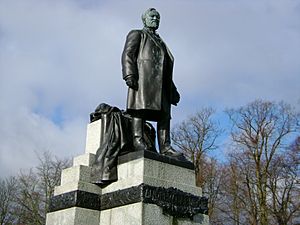
Carnegie received the honorary Doctor of Laws (DLL) from the University of Glasgow in June 1901, and received the Freedom of the City of Glasgow "in recognition of his munificence" later the same year. In July 1902 he received the Freedom of the city of St Andrews, "in testimony of his great zeal for the welfare of his fellow-men on both sides of the Atlantic", and in October 1902 the Freedom of the City of Perth "in testimony of his high personal worth and beneficial influence, and in recognition of widespread benefactions bestowed on this and other lands, and especially in gratitude for the endowment granted by him for the promotion of University education in Scotland" and the Freedom of the City of Dundee. Also in 1902, he was elected as a member to the American Philosophical Society. He received an honorary Doctor of Laws (LLD) from the University of Aberdeen in 1906. In 1910, he received the Freedom of the City of Belfast and was made as well Commander of the National Order of the Legion of Honour by the French government. Carnegie was awarded as Knight Grand Cross of the Order of Orange-Nassau by Queen Wilhelmina of the Netherlands on August 25, 1913. Carnegie received July 1, 1914 an honorary doctorate from the University of Groningen the Netherlands.
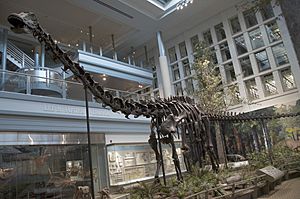
- The dinosaur Diplodocus carnegiei (Hatcher) was named for Carnegie after he sponsored the expedition that discovered its remains in the Morrison Formation (Jurassic) of Utah. Carnegie was so proud of "Dippy" that he had casts made of the bones and plaster replicas of the whole skeleton donated to several museums in Europe and South America. The original fossil skeleton is assembled and stands in the Hall of Dinosaurs at the Carnegie Museum of Natural History in Pittsburgh, Pennsylvania.
- After the Spanish–American War, Carnegie offered to donate $20 million to the Philippines so they could buy their independence.
- Carnegie, Pennsylvania, and Carnegie, Oklahoma, were named in his honor.
- The Saguaro cactus's scientific name, Carnegiea gigantea, is named after him.
- The Carnegie Medal for the best children's literature published in the UK was established in his name.
- The Carnegie Faculty of Sport and Education, at Leeds Beckett University, UK, is named after him.
- The concert halls in Dunfermline and New York are named after him.
- At the height of his career, Carnegie was the second-richest person in the world, behind only John D. Rockefeller of Standard Oil.
- Carnegie Mellon University in Pittsburgh was named after Carnegie, who founded the institution as the Carnegie Technical Schools.
- Lauder College (named after his uncle George Lauder Sr.) in the Halbeath area of Dunfermline was renamed Carnegie College in 2007.
- A street in Belgrade (Serbia), next to the Belgrade University Library which is one of the Carnegie libraries, is named in his honor.
- An American high school, Carnegie Vanguard High School in Houston, Texas, is named after him
- Carnegie was awarded the Freedom of the Burgh of Kilmarnock in Scotland in 1903, prior to laying the foundation stone of Loanhead Public School.
Images for kids
-
Carnegie, right, with James Bryce, 1st Viscount Bryce
-
Andrew Carnegie with his wife Louise Whitfield Carnegie and their daughter Margaret Carnegie Miller in 1910
-
The Andrew Carnegie Mansion, located on 5th Avenue in the Upper East Side, Manhattan, New York
See also
 In Spanish: Andrew Carnegie para niños
In Spanish: Andrew Carnegie para niños


